The White’s Tree Frog is one of the most popular species of pet frog. Their popularity comes from their impressive lifespan and striking appearances, and it has only increased since their introduction to the U.S. in 1980.
An average pet owner should consider captive-bred frogs to breed before considering wild or imported ones, because a captive-bred specimen usually has significantly better health conditions than those caught in the wild or imported.
Are you a breeder and looking for information on how to breed the White’s Tree Frogs? Or are you trying to jump into the elusive and mysterious world of breeding amphibians? Then this article is the right place! I will not deny the fact that I have the most expertise in breeding.
Here, I will try to guide you through the step-by-step procedure of having a successful breeding session of the White’s Tree Frogs.
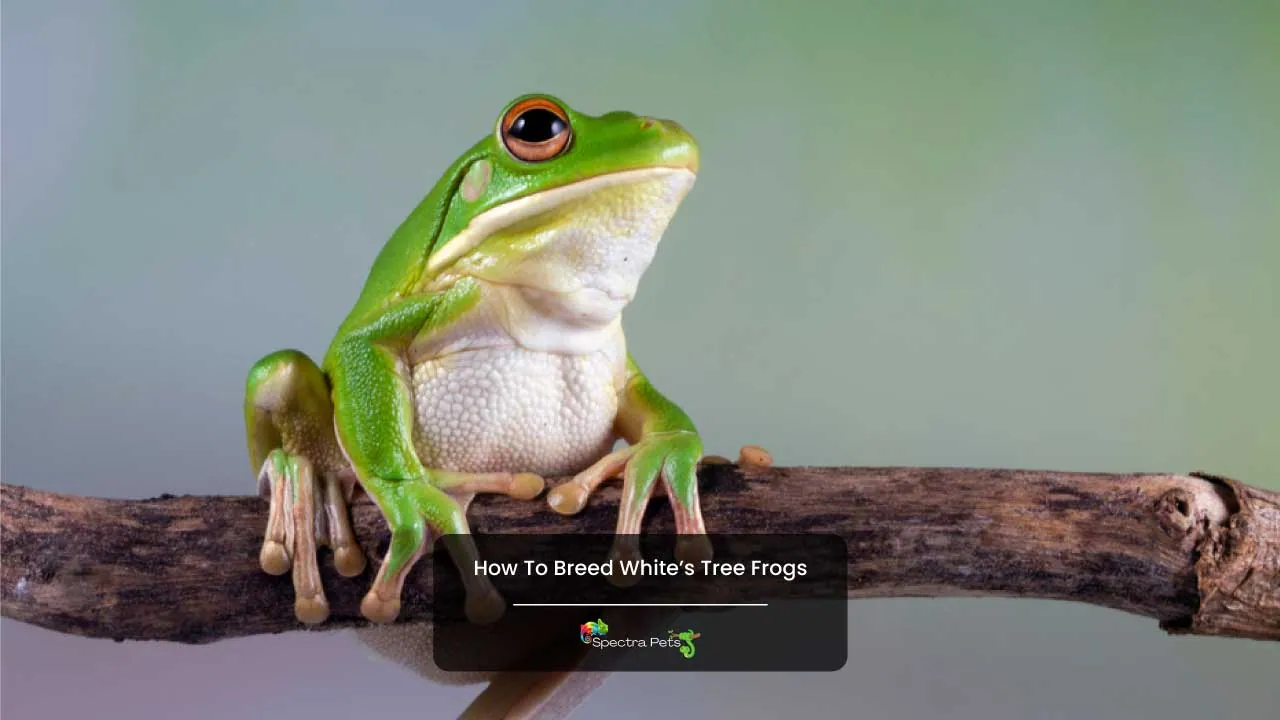
What is a White’s Tree Frog?
The White’s Tree Frog is a very calm amphibian that frequently coexists in close proximity to humans during its lifespan. These chubby frogs are also known by the name “dumpy tree frogs” because of their fat bodies and the large bumps on their heads which they develop as they age.
But don’t be surprised knowing that they’re green in color, since their actual name is Australian green tree frog. So why are they called White’s tree frogs? It’s because they got their name from John White, the person who first described them. It’s a way to honor his achievement.
Taxonomy
- Kingdom: Animalia
- Phylum: Chordata
- Class: Amphibia
- Order: Anura
- Family: Hylidae
- Genus: Litoria
- Species: L. caerulea
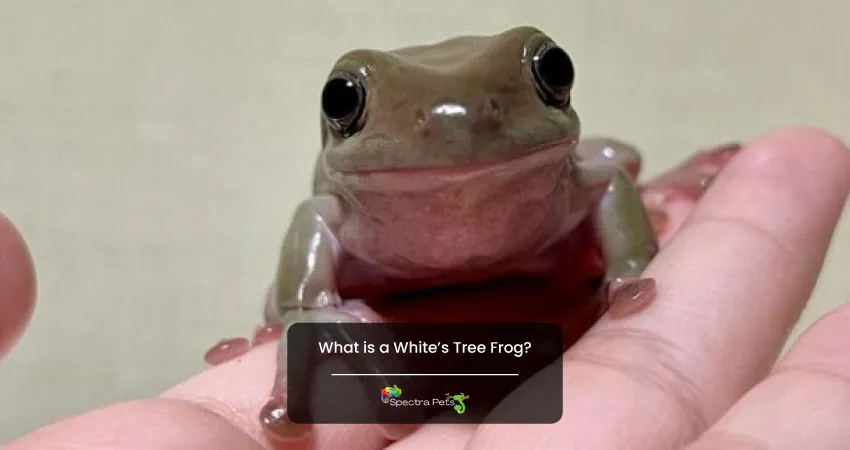
They can appear in a variety of hues, such as vivid green, gorgeous teal blue, and occasionally even purple. There is a specific line of captive animals known as the Snowflake, which are selectively bred and exhibit extreme amounts of white speckling all over their bodies.
These frogs make excellent pets for anyone because they are big in size and do not jump very often.
Related Article: Are White’s Tree Frogs Poisonous?
White’s Tree Frog Breeding: A Step-by-step Guide
White’s Tree Frogs are a robust species of frog, which allows beginners to proceed in a “trial and error” method. I would still strongly recommend educating yourself about their preferred temperature, food, lighting, habitat, and breeding procedure.
Some key things you need to consider when breeding White’s Tree Frogs:
- Environment and housing
- Distinguishing the gender
- Age
- Mating
- Diet
- Temperature
- Water
- The Rain Chamber
- Egg Care
- Tadpole Care
- Metamorphosis
- Froglet care
- Health Issues
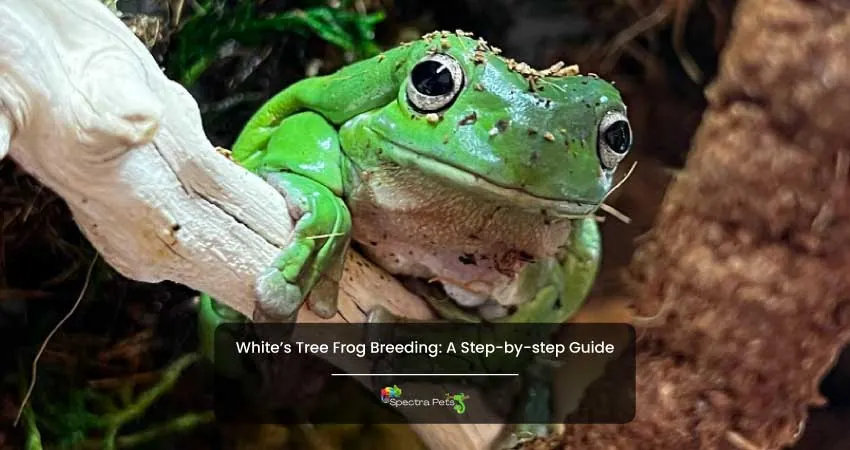
Let’s discuss further details about these White’s tree frog breeding factors.
1. Environment and Housing
For freedom of movement and happiness, adult White’s tree frogs require at least a 30-gallon tank. That does not necessarily imply that you need a 60-gallon tank to fit two adults inside. Two frogs can easily live in harmony in a 30 gallon tank.
The tank’s size is determined by how far it can jump. One frog cannot freely move inside a 10 or 20 gallon container. A 30-gallon container can accommodate two frogs without the need for constant cleaning.
I advise adding 10 gallons for each additional frog after the first couple. This translates to three frogs in 40 gallons, four of them in 50 gallons, five of them in 60 gallon, and so forth. Ammonia and feces would quickly accumulate in the area if it were any more crowded. This does not apply when you introduce the frogs to the rain chamber.
You can keep up to seven frogs in a 20 or 30 gallon tank without much difficulty while they are in the rain chamber. During this period, they are more focused on mating and do not attempt to escape. Once they have laid eggs, put them back in their usual enclosure.
I also recommend using ultraviolet fluorescent tubes for your White’s tanks, and the tank should receive some sunlight throughout the day. The frogs should have plenty of hiding spots in the tank so that they don’t get burned by the sun. I suggest two different strategies to deal with the heat.
In order to prevent overheating, you should first try to keep the room temperature they are in between 65 and 70 degrees Fahrenheit at night and up to 90 degrees Fahrenheit during the summer. Keep plenty of water on hand and mist the tank frequently. Due to evaporation, a moist substrate will continue to be cooler than the ambient temperature.
I advise placing an infrared heat lamp and an angled stick at one end of their enclosures so that there is a temperature gradient in the tank. Add several thermometers to the tank as well so you can monitor internal temperatures. You can bring in your frogs once you have a sense of how to control the tank temperatures.
Use regular lamp timers that can be adjusted in fifteen-minute increments. Digital lamp timers are also a better alternative. If you are serious and have had your frogs for some time, you probably have a good setup.
You should also avoid housing different species of frogs in the same tank. Some species prey on others, while others can outgrow and out-compete for food. Also, put same-sized frogs together. The larger frogs will introduce the same problem to the smaller ones and irritate them with their appearance.
2. Distinguishing the Gender
By the age of two, White’s treefrogs are sexually mature. The nuptial pads on mature males’ thumbs are thicker when they are in breeding condition, and they are smaller than females, with loose, slightly dark skin around their throats.
Related Article: How To Tell If A Frog is Male or Female
3. Age
I strongly recommend not trying to breed the White’s until the frog is three years old. It’s possible that these frogs breed earlier than that, and your males may call much earlier than that as well. However, in order to reproduce, they must cycle, and cycling puts stress on the frog’s body.
Most White’s frogs don’t begin to build up the fat reserves necessary to guarantee a positive response until they are two years old. You must keep in mind that cycling is an effort to mimic the frogs’ natural winter and dry season and can result in an animal’s demise.
Some frogs aren’t robust enough to endure the winters, just like in the wild. Although they never mention it in the books, it is a reality. The same weather conditions that cause their bodies to reproduce and lay eggs also cause weak or ill frogs to perish.
4. Mating
When buying young frogs, new breeders frequently want their frogs to be able to mate right away. This simply cannot be done, in my opinion, until the frogs are at least 9 months old. Some frogs aren’t physically able to mate in their first year.
The most common knowledge is that the females are usually a bit larger than the males and that only the male frogs call. However, sometimes the females also look almost identical to the males, and the females call as well. The females actually make a harsh noise when annoyed or being handled.
Despite some common knowledge being accurate, sometimes things vary between individual frogs because of their wide variety. So, the best practice is to observe your frogs for a year to get a better understanding of their behavior.
Males frequently begin sounding different when they hear sounds that resemble another White’s calling. Even the males that are reluctant to call will start calling once they hear other frogs, and cycling also initiates calling.
When the frogs go through proper cycling, you will start to see dark regions around the male’s thumbs on the front. These dark regions are known as nuptial pads, and these pads are helpful in attracting females.
Another great idea is to play recordings of the male frog’s calling before you bring the frogs to the rain chamber. This typically results in the frogs starting to call immediately. The females will start making noise once they hear this. This doesn’t last longer than 5-6 seconds.
On the other hand, the male frogs begin to call in a quiet tone and build up their voice into a loud chain of croaks. Their calls last up to 40 seconds. The females will grow larger than the males in most cases.
5. Diet
Diet plays a vital role in breeding the White’s Tree Frog. They mostly require live insects, such as pinkie mice, worms, and crickets. When choosing their food, you should consider their body size. The size of the prey should never be larger than that of the froglet.
At the beginning, you should feed them crickets. These insects are very nutritious. You should spray some mineral nutrition on the crickets as you feed them to your frogs. One pinkie mouse a week is also a great idea. Before you feed the crickets to your frogs, you can feed the insects some vegetables such as kale or dark lettuce approximately 10 hours ahead.
I strongly recommend feeding your frogs heavily for 30 straight days.
6. Temperature
In the enclosure, the ideal temperature during the day should be between 80°F and 85°F, with a plus or minus 5°F variation. The temperature should drop from 72°F to 75°F at night. You should introduce a lamp from 7 am to 8 pm.
Ensure the temperature is maintained throughout the whole period and feed the frogs properly. When the weather gets colder, decrease the temperature to 75°F in the daytime and to 70°F during the nighttime.
Do not mist the tank; instead, keep filling a shallow bowl with water. Now it’s time to stop feeding since the frogs cannot digest food properly at lower temperatures. Also, during this time, their bellies need to be empty as they enter hibernation.
7. Water
You should set up a separate tank that has gravel and lots of plants in it. Additionally, you should install a filter under the gravel and another powerhead pump. A few limestone rocks also help to improve the water quality.
If you have a freshwater source anywhere nearby, I recommend filling this tank with water from there. As long as the water is boiled, it should get rid of all the bacteria without losing any of the mineral contents.
For two weeks straight before you bring your frogs to the rain chamber, run the pumps and filters regularly.
8. The Rain Chamber
Your rain chamber should consist of a simple tank that houses about 40 gallons of water, rocks, and a powerhead pump attached to a filter that is attached to a pipe with a hole every inch.
Once you turn the pump on, it should simulate rainfall inside the tank. Run the pump from 4 p.m. to 8:30 p.m. every night until you see your frogs laying eggs. You can also install a humidifier in the room in order to help your frogs breed.
Have five males and three females in one rain chamber. The count really depends on how many frogs you have cycled. But, having this number introduces some competition and initiates louder calling. It kind of stimulates a behavior that is seen in wild frogs.
The frogs start jostling for position as the calling gets going. Now you should introduce other frogs that have not been in the same rain chamber.
But, keep in mind, before you introduce alien frogs to the tank, you should keep them in quarantine for at least 90 days. This is strongly recommended to keep your anurans away from diseases that outsiders might bring with them.
Now, in order to accelerate things, you can consider bringing in a tape that has recordings of the White’s calls. This will increase the competition amongst males even further.
You’re done! Now you just have to wait to see the results. If you have followed everything thoroughly, you should see your tiny amphibians clinging to each other and laying eggs in the water in 2 to 10 days. If the day count exceeds 4 and you still haven’t seen any eggs in your terrarium, you should bring in some food.
I suggest you take the frogs out of the tank once 12 days have passed. Turn off the pump as it is not required anymore. The frogs in the tank risk damaging the eggs. If everything went well, there should be between 800 and 1200 eggs in the tank.
9. Egg Care
Now that you have your eggs, the waiting starts!
The eggs have a jelly-like appearance that is clear with black dots. The eggs will hatch within another 10-12 days.
On rare occasions, an egg cluster might not be fertile. If the eggs don’t show any signs of development for several days and then start to crumble or mold, throw them away.
Also, in a healthy batch of eggs, there might be a few odd eggs that are infertile. If you see them molding, remove them immediately as they will contaminate the whole batch of eggs.
10. Tadpole Care
As soon as your eggs hatch, a plethora of tiny tadpoles will swarm your tank. They are about 0.8 inches small and have black dots all over them. They will cling to the sides of the tank for the next two days. You should keep them warm with the heater during this time.
When the tadpoles start moving and gathering, transfer them to the tank mentioned in the water section. After transferring your tadpoles, regulate your tank temperature to 85°F. During this period, feeding them tiny worms is recommended.
Your tadpoles will mostly remain immobile during the first few weeks. Change ⅓ of the water every 5 to 6 days in order to maintain the water quality. Make sure you have enough backup water for this.
11. Metamorphosis
In about two weeks, the tadpoles will start developing rear legs. Prepare a different aquarium with about 40 gallons of water in it. Keep in mind that you need a lid for this aquarium, as the tadpoles will try to jump out. Also, bring in a few floating plants for the tadpoles to have some footing.
Now you need to observe your tadpoles very closely. The ones that are bigger, especially those with developed rear legs, will begin to have heads that are more angular. Soon you can see them developing forelimbs just under their skin. Once the forelimbs are pretty visible, the tadpoles are about 16 hours away from completely transforming into froglets.
12. Froglet Care
I suggest you keep a tank that is 10 gallons in size and has a safe top that has a see-through panel that allows you to observe any froglets. When froglets are 1.5 inches long, you can place up to eight of them in the tank.
Put either two froglets in a 20-gallon tank or four in a 30-gallon tank, depending on how long they are from snout to vent, which is 2 inches. If you crowd the tank any more than that, be prepared to clean it every day.
You need to use a paper towel substrate, which I like to keep damp, along with a small water bowl and a few tiny branches leaning against the corners to help with perching.
Additionally, you can frequently add moss to the top of the plant’s pot and place a small potted plant in the tank with unfertilized potting soil. The presence of the plant in the tank ensures that the froglets have a moist hiding spot even if the paper towel becomes dry. Every third day, wash the water bowl, change the substrate, and clean the interior glass.
Every four weeks, remove everything from the tank and wash it with 5% bleach mixed into a water solution. Tree branches or any other type of wood product in the tank would be the only exception; place these in a pan and cover them with boiling water. Wash the wood fibers thoroughly after using bleach to prevent soaking.
Allow the tank and water bowl to dry in the sun as much as you can. Any remaining bleach is assisted in decomposition by the ultraviolet light. Replace the moss or brush off the soil in the pot and wipe the outside of the potted plant with a bleach solution, being careful not to get any solution into the soil.
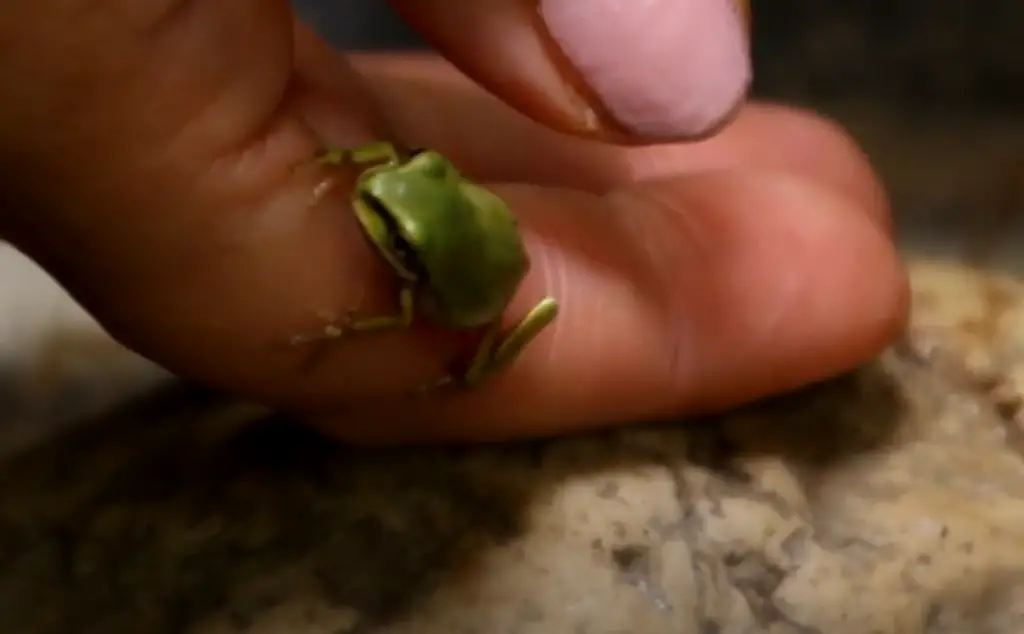
Although the set-up is very straightforward, maintenance is made simpler when you take into account the sum of froglets you can house and the amount of waste they produce as they continue to grow.
Feed the froglets crickets that are the right size and have previously been fed dark lettuce. If your froglets seem to be extremely hungry and finish feeding on the crickets very quickly, you should increase the insect’s size. When choosing a size, put your common sense into practice.
Add a calcium supplement by dusting it on the crickets every second feeding. Maintain the temperature needs as if they were adult frogs. The easiest way to do this is to heat up the entire room. Your tank will quickly dry out from using infrared heat lamps, frying any frogs that are present. With froglets, a constant temperature of 80°F is fine; differentiating daytime and nighttime temperatures is not really important.
The best practice is to utilize indirect natural sunlight during the froglets’ photoperiod. You can place the tank in your backyard/garden shed and do not expose it to direct sunlight. Keep in mind that the position of the sun changes in a particular way. Your tank should not come in contact with direct, harsh sunlight in any way.
If you somehow have no access to natural sunlight, installing a timer-based UV fluorescent lamp is a great alternative. You should set the lamp at a 12-hour interval.
Keep watching your frogs closely as they grow. Once you have the feeling that they are larger than the setup, it’s time to move on. Most frogs will continue to grow for 36 months.
How many eggs does a White’s Tree Frog lay?
A female White’s Tree Frog releases her eggs with enormous force. The eggs break through the cloud of sperm and move up to 1.5 feet away because of the force. One single clutch can contain 150-300 eggs.
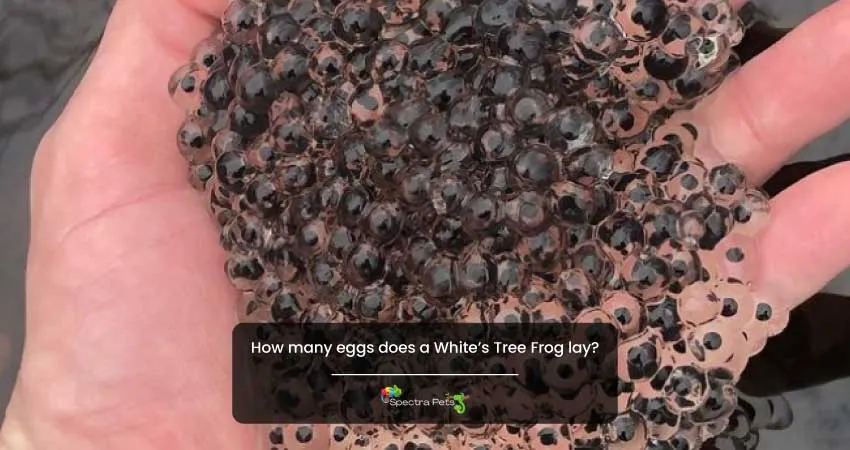
The eggs sink to the bottom after fertilization. Hatching happens between 28 and 36 hours later. Under ideal circumstances, metamorphosis can take place in two to three weeks.
Wrapping Up
Achieving brilliant results in breeding the White’s is a remarkable accomplishment and it can translate to a generous income source. If you have followed all the steps thoroughly and achieved similar results, then congratulations! You have successfully bred the White’s Tree Frog and stepped into the right direction of breeding amphibians. If not, then look back and compare your actions with those mentioned in this article and see if you have missed something.

